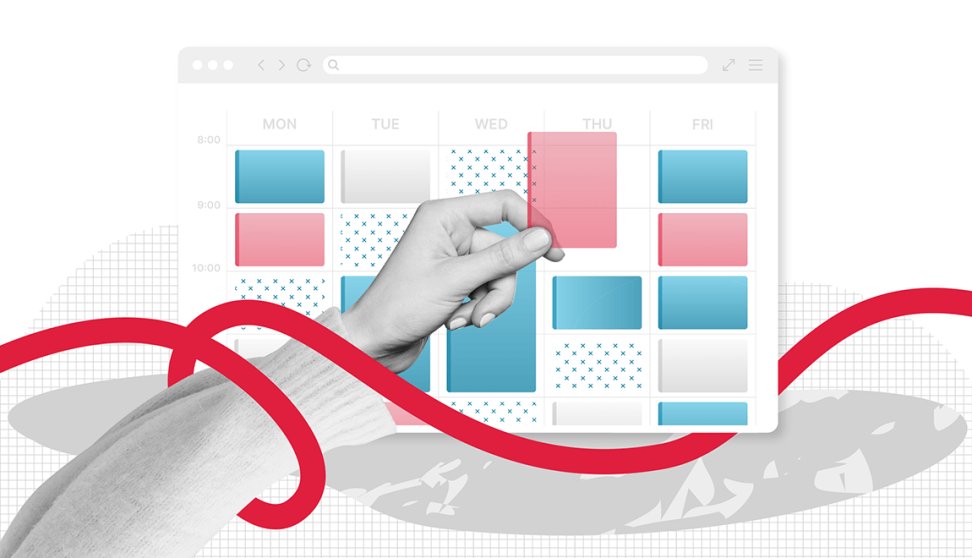6 Steps to Create a Weekly Work Plan

A weekly work plan is a physical or digital document aimed at helping you organize and schedule tasks for a specific week. These plans can be individual (i.e., made for one person) or designed to help teams stay on track with their tasks, work obligations, and deadlines.
The main purpose of a weekly work plan is to provide a roadmap for successfully managing time and prioritizing work duties in order to reach weekly objectives.
You can use a calendar or piece of paper to create your weekly work plan. Alternatively, if you feel like you need something more sophisticated, you can try out various software solutions. Let’s dive into what’s the most effective way to create a weekly work plan that works for you.- How to Create a Weekly Work Plan in 6 Steps
- 1. Choose How and When You Want to Do It
- 2. Record Your Long-Term Goals
- 3. Figure Out Tasks for the Week
- 4. Schedule Tasks
- 5. Stick to the Plan
- 6. Review and Adjust the Plan (If Necessary)
- Tips to Maintain Your Weekly Work Plan
- Leave Some Time for the Unexpected
- Try to Make Yourself More Accountable
- Keep an Eye on Your Energy Levels
- Main Benefits of Having a Weekly Work Plan
How to Create a Weekly Work Plan in 6 Steps
1. Choose How and When You Want to Do It
To start your journey of creating a weekly plan, you should first choose the way you want to do it. You have two options:
- You can use organizational software to help you generate and visualize your weekly schedule (digital solution)
- You can use a regular piece of paper, calendar, or a planner to write down your weekly plan (handwritten solution)
Whichever way you choose to go, keep one thing in mind — you need to make your pick based on what will be the easiest for you to stick to. A weekly plan is useful only if you use it consistently.
After you’ve settled on your preferred method, it’s time to choose a specific day of the week to create and assess your weekly work plan. Going with Monday is the safest bet, as it is the actual start of the typical workweek. But, if your schedule is different, or your workweek doesn’t start on Monday, you can pick whichever day you want
2. Record Your Long-Term Goals
Make a list of all of your long-term goals (your personal or those of your team or company). You can use the SMART method to help you figure out which goals to focus on. After that’s settled, you can use that list to ensure all of your weekly tasks are moving you toward achieving those goals.
For example, let’s say that your long-term goal is to streamline payroll processes in your company. But, before you can achieve that, you need to evaluate your company’s payroll processing methods so you can see where the gaps are, what you can improve, and what areas are suitable for automation.
In that case, your weekly goals could be: Evaluate the payroll processing systems of my company; Analyze all relevant departments; Discern and evaluate how payroll data is distributed across my company’s internal information network; and so on.
3. Figure Out Tasks for the Week
Now it’s time to try and divide your long-term goals into more manageable smaller pieces (i.e., weekly tasks) and figure out which of those you can finish during a single week. For example, if your goal is to improve the staff scheduling of your company, you could add the following task to your weekly work plan — evaluate the staff scheduling methods of my company.
While you work on figuring out tasks for your weekly schedule, you’ll soon realize that some tasks are more consequential and will push you further toward your goals than others. Keep that in mind when creating your weekly work plan. Consider what tasks can help you reach your objectives faster, and schedule them accordingly.
You can also make a list of all your priorities (personal or professional) as a way to review what tasks you should put most of your time into. If you have trouble doing this by yourself, you should try out the Eisenhower Matrix prioritization technique.
4. Schedule Tasks
Once you’ve figured out all the weekly tasks, it’s time to start scheduling them. Set aside enough time to work on the ones you chose, and note them in either your physical planner (calendar, piece of paper, etc.) or the software interface (if you went with a digital solution).
If it’s your first time making a weekly work plan, try to schedule your tasks realistically and leave ample time for each one. Don’t sell yourself short, but also don’t overestimate what you can do in a single day or week.
If you’re dealing with a particularly difficult task, don’t try and force it into one day, but rather split it into two. This way, if you finish it quicker you can feel good about yourself, instead of feeling bad if you aren’t able to complete it in one day.
And, if you need help getting started, you can always try a technique that can help you with task scheduling, such as Timeboxing.
5. Stick to the Plan
Now that you have everything set up and running, it’s important to stick to your weekly work plan. You can check your plan as often as you want, as a reminder and to ensure that you’re doing the tasks you’ve set out to do for the week.
6. Review and Adjust the Plan (If Necessary)
If it’s your first time creating a weekly work plan, you’re bound to encounter some hiccups along the way, but don’t let those discourage you. Instead, whenever you run into problems, write them down and use them as an opportunity to review and adjust your weekly work plan.
Maybe you need to switch up your goals or figure out some new tasks to add to your plan. Or maybe you can delegate some of your tasks to competent team members?
Whatever the case may be, try and regularly examine your plans and adjust them as necessary. Do that even if you don’t come across any issues. Remember, a lot of things can be streamlined (including a weekly work plan), and the only way you can do that is to review your current processes.
Tips to Maintain Your Weekly Work Plan
Maintaining your weekly work plan can be a challenging habit to instill. That’s why we’re including some tips to help you maintain your consistency and keep a positive attitude toward planning your weekly schedule.
Leave Some Time for the Unexpected
No matter how well you’ve planned things out, unexpected situations are bound to happen. This is not something that you can predict, but what is in your control to do is set aside some time in your weekly work plan to deal with the unexpected (e.g., emergency meetings or project bottlenecks).
Try to Make Yourself More Accountable
Making yourself more accountable is a good way to ensure you’re actively working on and sticking to your weekly work plan. One way you can achieve that is by talking to other people about your goals and plans for the week as a means to give yourself additional motivation to complete them.
Additionally, talking about your tasks and goals with your team or higher-ups is a good way to keep everybody in the loop about your progress.
Keep an Eye on Your Energy Levels
The energy levels of most people change throughout the day. Some are more energetic in the early hours of the day, while others are more productive in the evening. Consider your energy levels, and try to plan your daily tasks accordingly.
For example, if you’re an early bird, you might want to schedule the most difficult tasks for the morning. On the other hand, if you’re not into performing strenuous work while roosters are still crowing, you should probably schedule the more complicated tasks for later in the day (noon, afternoon, or even evening).
Main Benefits of Having a Weekly Work Plan
A weekly work plan is a great way to represent all of your work obligations in a visual way. It’s a way to schedule your entire week ahead of time and can help you:
- Set up a routine — Creating and sticking to a routine strengthens neural pathways and promotes engagement and productivity, according to an MIT study. And it can also help you organize your weekly tasks (work or otherwise) to make them easier to perform.
- Improve efficiency — By noting down all of your weekly tasks and allocating time for each, you can lower the chances of procrastination and ensure that your time is used as efficiently as possible. It can also help focus and stay on track with your weekly objectives
- Manage stress — Having a set routine and knowing what your weekly tasks are in advance can have a positive effect on the way you deal with stress. And the less stress you feel, the more relaxed you are going to be while working on your weekly tasks.
- Keep up with the deadlines — With a weekly work plan, you’ll know exactly when and which of your tasks are due to be completed. This will be of tremendous help when trying to keep up with the ever-more demanding deadlines and schedules of the modern workplace.
- Maintain a positive work-life balance — Having a weekly work plan allows you to schedule your free time. With it, you’ll know exactly how much spare time you’ll have to spend doing things that you enjoy, like hanging out with your friends, family, or loved ones, exercising, going to the movies, and similar. Remember, spending your free time to recoup and enjoy yourself is the best way to maintain a good work-life balance.



